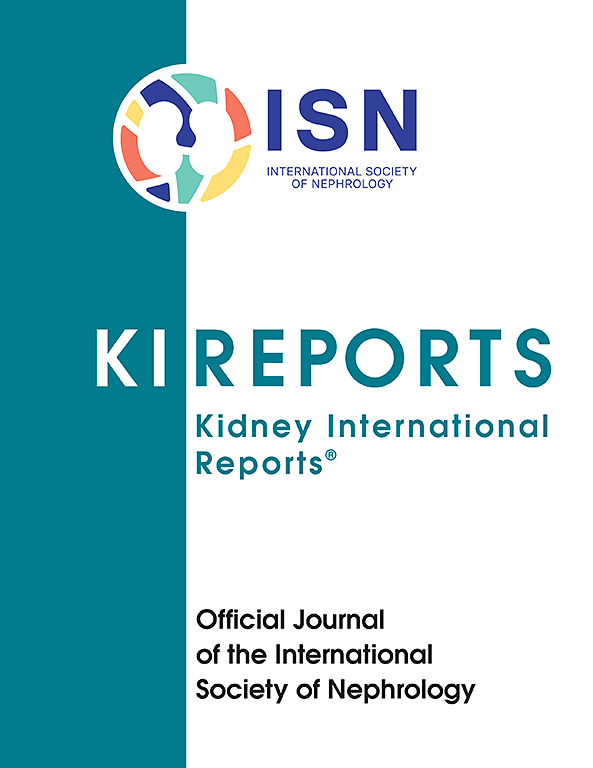利妥昔单抗治疗抗肾小球基底膜病的疗效和安全性
IF 5.7
2区 医学
Q1 UROLOGY & NEPHROLOGY
引用次数: 0
摘要
抗肾小球基底膜(GBM)疾病是由病原性抗体引起的,通常靶向IV型胶原α3链的非胶原结构域,通常表现为快速进展的肾小球肾炎和弥漫性肺泡出血(DAH)。快速减少这些抗体对肾脏存活至关重要,主要的治疗方法是联合血浆交换(PLEX)、糖皮质激素和环磷酰胺。利妥昔单抗被认为是抗gbm疾病的潜在治疗方法;然而,缺乏有效性和安全性的数据。方法:我们回顾了病例报告和系列(n = 28),提供了利妥昔单抗治疗成人和儿童抗gbm疾病的有效性和安全性的个体患者水平数据。此外,我们还收到了来自作者的18例患者的数据,这些数据来自4项研究,这些研究没有报道患者水平的结果或以前没有报道过。对PubMed/MEDLINE检索的研究进行检索,然后对数据进行综合和分析。结果67例患者中,女性37例(55%);儿科14例(21%);中位年龄:37岁]被随访,共87.1人年(中位随访时间:9.5个月)。他们接受利妥昔单抗作为一线(n = 39)或二线(n = 28)。血清肌酐中位数为416 μmol/l, 32例(48%)患者就诊时依赖透析,24例(36%)患者患有DAH。静脉脉冲、口服糖皮质激素和PLEX分别占85%、98%和93%;54%的患者接受环磷酰胺治疗。患者接受中位4(2-4)剂量的利妥昔单抗治疗,其中11例患者(16%)出现短暂不良反应。患者生存率为91%,肾脏生存率为67%(成人为53%,儿科为71%)。最初依赖透析的患者肾脏存活率较低(34% vs. 81%, P <;0.001)。接受二线利妥昔单抗治疗的患者与接受一线利妥昔单抗治疗的患者相比有更好的肾脏生存(73%对46%,P = 0.03)。结论承认本研究的局限性,包括发表和选择偏倚,利妥昔单抗具有良好的毒性和疗效。结果表明,当环磷酰胺禁忌时,利妥昔单抗可作为抗gbm疾病的二线治疗。本文章由计算机程序翻译,如有差异,请以英文原文为准。

Efficacy and Safety of Rituximab in Antiglomerular Basement Membrane Disease
Introduction
Anti–glomerular basement membrane (GBM) disease is caused by pathogenic antibodies usually targeting the noncollagenous domain of the α3 chain of type IV collagen and frequently presents as rapidly progressive glomerulonephritis and diffuse alveolar hemorrhage (DAH). Rapid reduction of these antibodies is imperative for kidney survival and the mainstay of therapy is the combination of plasma exchange (PLEX), glucocorticoids, and cyclophosphamide. Rituximab has been postulated as a potential treatment for anti-GBM disease; however, data on efficacy and safety are lacking.
Methods
We performed a review of case reports and series (n = 28) providing individual patient-level data on the efficacy and safety of rituximab in adult and pediatric anti-GBM disease. In addition, we have received data from authors on 18 patients which stem from 4 studies that did not report on patient-level outcomes or were not previously reported. A search strategy of studies indexed in PubMed/MEDLINE was performed, followed by synthesis and analysis of the data.
Results
Sixty-seven patients [37 female (55%); 14 pediatric (21%); median age: 37 years] were followed-up with for a total of 87.1 person-years (median follow-up time: 9.5 months). They received rituximab as first-line (n = 39) or second-line (n = 28). Median serum creatinine was 416 μmol/l with 32 patients (48%) being dialysis-dependent at presentation and 24 (36%) having DAH. Intravenous pulse, oral glucocorticoids and PLEX were used in 85%, 98%, and 93%, respectively; and 54% of them received cyclophosphamide. Patients received a median of 4 (2–4) doses of rituximab with 11 patients (16%) having transient adverse effects. Patient survival was 91% and kidney survival was 67% (53% in adults and 71% in pediatric patients). Kidney survival was lower in initially dialysis-dependent patients (34% vs. 81%, P < 0.001). Patients receiving second-line rituximab had better kidney survival compared with those receiving it as first-line (73% vs. 46%, P = 0.03).
Conclusion
Acknowledging the limitations of our study, including publication and selection bias, rituximab had a favorable toxicity and efficacy profile. The results indicate that rituximab can be considered as a second-line therapy in anti-GBM disease when cyclophosphamide is contraindicated.
求助全文
通过发布文献求助,成功后即可免费获取论文全文。
去求助
来源期刊

Kidney International Reports
Medicine-Nephrology
CiteScore
7.70
自引率
3.30%
发文量
1578
审稿时长
8 weeks
期刊介绍:
Kidney International Reports, an official journal of the International Society of Nephrology, is a peer-reviewed, open access journal devoted to the publication of leading research and developments related to kidney disease. With the primary aim of contributing to improved care of patients with kidney disease, the journal will publish original clinical and select translational articles and educational content related to the pathogenesis, evaluation and management of acute and chronic kidney disease, end stage renal disease (including transplantation), acid-base, fluid and electrolyte disturbances and hypertension. Of particular interest are submissions related to clinical trials, epidemiology, systematic reviews (including meta-analyses) and outcomes research. The journal will also provide a platform for wider dissemination of national and regional guidelines as well as consensus meeting reports.
 求助内容:
求助内容: 应助结果提醒方式:
应助结果提醒方式:


